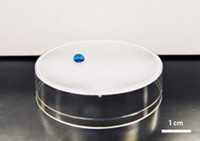Advertisement
Grab your lab coat. Let's get started
Welcome!
Welcome!
Create an account below to get 6 C&EN articles per month, receive newsletters and more - all free.
It seems this is your first time logging in online. Please enter the following information to continue.
As an ACS member you automatically get access to this site. All we need is few more details to create your reading experience.
Not you? Sign in with a different account.
Not you? Sign in with a different account.
ERROR 1
ERROR 1
ERROR 2
ERROR 2
ERROR 2
ERROR 2
ERROR 2
Password and Confirm password must match.
If you have an ACS member number, please enter it here so we can link this account to your membership. (optional)
ERROR 2
ACS values your privacy. By submitting your information, you are gaining access to C&EN and subscribing to our weekly newsletter. We use the information you provide to make your reading experience better, and we will never sell your data to third party members.
Materials
Cleaning Acrylics
Conservation scientists seek new ways to keep modern paintings looking their best
by Celia Henry Arnaud
October 17, 2011
| A version of this story appeared in
Volume 89, Issue 42

On a museum timescale, acrylic paints are still new. Acrylic paints were invented in the late 1940s, and the first wave of acrylic paintings in museum collections is now between 50 and 60 years old. In the past decade, conservation scientists realized they needed to learn how to clean these modern materials.
Acrylic paints are basically pigments suspended in an emulsion of acrylic polymer in water. Keeping the pigments in suspension requires additives such as surfactants, molecules with hydrophilic and hydrophobic portions that allow them to interact with both water and organic solvents.
The surfactants and other additives hold the liquid paint together in the tube and on the artist’s palette and brush; after the paint has dried on a surface, their original job is done. But conservators and conservation scientists are finding that these necessary paint components can lead to trouble later. They work their way to the surface, where they can affect the appearance, even forming a thin white film in extreme cases.
And the surfactants in acrylics may make those paintings particularly susceptible to soiling. Acrylic paintings are rarely varnished, so there’s nothing between the paint and the dirt. Acrylics are softer than traditional oil-based paints, so dust and other debris are more likely to stick to the paint or become embedded in it, says Bronwyn Ormsby, a conservation scientist at Tate, a family of four museums in England.
“We haven’t had a lot of experience with cleaning or conserving these paints,” says Richard C. Wolbers, a conservation scientist at the University of Delaware. “At the moment, we don’t really have a great way of cleaning these paint films.”
Conservators usually start with dry methods of cleaning acrylic paintings, such as using brushes or sponges to remove soiling, Ormsby says. If that doesn’t do the trick, they move on to wet cleaning, with water or other solvents.
But the problem is that acrylic paint films swell in most solvents. Conservators don’t know whether that swelling causes long-term changes in the properties of the paints. “These paints seem to swell in every kind of solvent except the least polar,” Wolbers says. “The most aliphatic solvents minimize that swelling and extraction of material from the paint. Almost everything else, including water, really will take something out of these films.”
Nonpolar hydrocarbon solvents known as mineral spirits or white spirits cause the least swelling. Unfortunately, those solvents are also “pathetic cleaners,” says Thomas J. S. Learner of the Getty Conservation Institute in Los Angeles. Thus, the hunt is on to find systems that actually clean acrylic paintings without damaging them.
Wolbers is working on one such project in collaboration with chemist Anthony F. Lagalante at Villanova University. They are looking for optimal conditions for cleaning paint films of different formulations and colors.
“Each pigment has a slightly different recipe,” says Courtney Dillon, a graduate student in Lagalante’s group. “And each pigment has its own response to cleaning solutions.”
Dillon has tested 192 aqueous systems for cleaning seven major pigments. Using salts, she adjusts pH, ionic strength, and conductivity. She applies the solution to paint films and quantifies materials such as surfactants removed from the paint, looking for a relationship between such losses and visual changes in the paint.
As part of the project, Wolbers and his collaborators have entered into an agreement with Golden Artist Colors under which the company supplies them with paints and with more information than is usually available about the various formulations. In their studies, they are artificially aging paint films and testing how they respond to various solvents, Wolbers says.
“Paint manufacturers are designing paints for speed of application, rate of drying, brush marking—things that might be part of the performance of the material as an art-making material,” Wolbers says. “Our job takes over after the paint is made into an art piece. Once it’s actually made into a painting, it becomes something else with its own deterioration properties or aging properties or extraction properties.”
Promising cleaning systems use microemulsions of aqueous phases in hydrocarbon solvents, Wolbers says. He’s also looking at even less polar solvents—silicon-based solvents. “Those solvents have the least swelling and the least extractive conditions for these kinds of paints,” he says. “Fluorinated and silicon-based solvents are looking promising for delivering small aqueous phases and not extracting a lot of materials from these films.”
A second project involves a museum-industry collaboration. Ormsby, Learner, and their colleagues, teaming with scientists at Dow Chemical, are likewise pursuing microemulsions for cleaning acrylic paints. They are harnessing Dow’s high-throughput robotic system to make and test upward of 50 new formulations at a time. They modified the robots to mimic the movements of a conservator rolling a damp swab over a paint surface. They calibrated the system with cleaners that are considered poor, middling, and effective, Learner says.
“We set Dow loose on producing formulations that would give consistently good cleaning results,” Learner says. The scientists quickly found surfactants and other products that remove dirt without affecting the paint film, he says. In this way, they’ve found a range of potential cleaning systems based on water, mineral spirits, and microemulsions.
Microemulsions address a number of issues simultaneously, Ormsby says. Because the paint films are porous, soft, and susceptible to solvent exposure, “it’s a good idea for us to get in and out of the paint as quickly as possible,” she says. The microemulsion systems are relatively fast acting. The combination of water and organic solvents allows them to remove a range of soil components that differ chemically.
But there is a downside to such quick action. Some conservators believe the cleaners act too quickly and are hard to control. “If you’ve got a thick layer, you’re moving through the dirt, and you eventually know you’ve hit the paint film because there’s a different feel,” Ormsby says. “Conservators become comfortable with a certain time frame to break through the soiling or the varnish layer or whatever they’re trying to remove. If they put something on a painting and they can’t control the action, they feel uncomfortable, and probably rightly so.”
With the advent of microemulsion systems, “there’s very little missing from the toolbox in terms of products,” Learner says. “The next phase of this research needs conservators to actually use these materials, get a feel for them, and give us feedback.” ◾





Join the conversation
Contact the reporter
Submit a Letter to the Editor for publication
Engage with us on Twitter